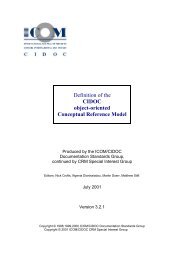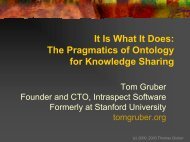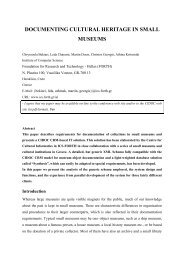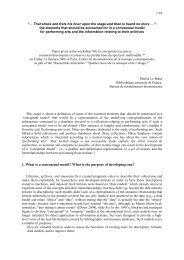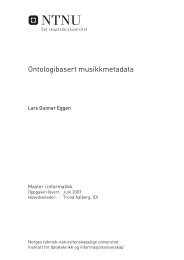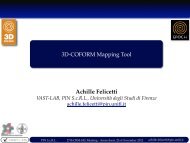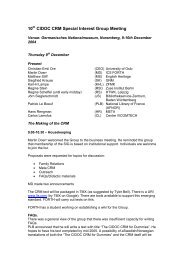Ontological Requirements for Annotation and ... - The CIDOC CRM
Ontological Requirements for Annotation and ... - The CIDOC CRM
Ontological Requirements for Annotation and ... - The CIDOC CRM
You also want an ePaper? Increase the reach of your titles
YUMPU automatically turns print PDFs into web optimized ePapers that Google loves.
Fig. 3. Reification of ideas through the interpretation class<strong>The</strong> interpretation class, a subtype of event, is meant to abstract the act of interpretingsomething, intended as the process by which we attribute a meaning to an object (cf. alsofig. 3). In ontological terms, this translates to associating an instance of propositionalcontent(i.e. the idea representing the interpretation) to any other instance of the ontology(i.e. the interpreted-thing). Of course, since an interpretation is also an event it inheritsvarious properties which capture useful in<strong>for</strong>mation such as the author of the interpretation(carried-out-by property), the time it was made (has-time-specification property), etc..For example, in our Wittgenstein-related knowledge base we can have the followinginstance (see also section 4.1):(def-instance interpretation-001 concept-interpretation((interprets a-posteriori-by-wittgenstein)(has-related-concept experience-by-wittgenstein prop-of-science-concept)(has-opposite-concept a-priori-by-wittgenstein laws-of-logic-concept)(is-equivalent-to <strong>for</strong>m-prop-science-concept)(is-related-to-idea mesh-metaphor fate-science-analogy)(carried-out-by michele-pasin)(has-time-specification 10-dec-08))In this case we are describing the properties of the concept of “a-posteriori byWittgenstein” in such a way that these descriptions will be associated only to a specificuser (i.e. the value of the property carried-out-by) <strong>and</strong> time (i.e. the value of the propertyhas-time-specification). This is possible because the concept-interpretation class (afurther specification of idea-interpretation) possesses all the properties normally used<strong>for</strong> describing an instance of concept: <strong>for</strong> example, has-related-concept, has-opposite-concept,is-equivalent-to, etc. (cf. section 3.7). <strong>The</strong> result of this ʻreificationʼ mechanism is that wecan have different descriptions of the same concept (<strong>and</strong>, in general, of any idea 5 )coexisting within the same knowledge base. In other terms, we are providing support <strong>for</strong>concurring <strong>and</strong> possibly contradictory in<strong>for</strong>mation management. In future versions of ourwork, this feature is likely to be further developed with more complex mechanism to



